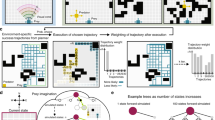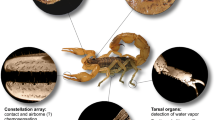Abstract
Movement and searching behaviors at diverse spatial scales are important for understanding how animals interact with their environment. Although the shapes of branches and the voids in arboreal habitats seem likely to affect searching behaviors, their influence is poorly understood. To gain insights into how both environmental structure and the attributes of an animal may affect movement and searching, we compared the three-dimensional exploratory movements of snakes in the dark on two simulated arboreal surfaces (disc and horizontal cylinder). Most of the exploratory movements of snakes in the dark were a small fraction of the distances they could reach while bridging gaps in the light. The snakes extended farther away from the edge of the supporting surface at the ends of the cylinder than from the sides of the cylinder or from any direction from the surface of the disc. The exploratory movements were not random, and the surface shape and three-dimensional directions had significant interactive effects on how the movements were structured in time. Thus, the physical capacity for reaching did not limit the area that was explored, but the shape of the supporting surface and the orientation relative to gravity did create biased searching patterns.




Similar content being viewed by others
References
Alexander RM (2003) Principles of animal locomotion. Princeton University Press, Princeton
Autumn K, Sitti M, Liang YA, Peattie AM, Hansen WR, Sponberg S, Kenny TW, Fearing R, Israelachvili JN, Full RJ (2002) Evidence for van der Waals adhesion in gecko setae. Proc Natl Acad Sci USA 99:12252–12256
Avni R, Zadicario P, Eilam D (2006) Exploration in a dark open field: a shift from directional to positional progression and a proposed model of acquiring spatial information. Behav Brain Res 171:313–323. doi:10.1016/j.bbr.2006.04.006
Benhamou S (2007) How many animals really do the Levy walk? Ecology 88:1962–1969
Biewener AA (2003) Animal locomotion. Oxford animal biology series. Oxford University Press, New York
Byrnes G, Jayne BC (2012) Three-dimensional trajectories affect gap bridging performance and behavior of brown tree snakes (Boiga irregularis). J Exp Biol 215:2260–2611
Cartmill M (1985) Climbing. In: Hildebrand M, Bramble DM, Liem KF, Wake DB (eds) Functional vertebrate morphology. Belknap Press, Cambridge, pp 73–88
Edwards AS (1946) Body sway and vision. J Exp Psychol 36:526–535
Edwards AM, Phillips RA, Watkins NW, Freeman MP, Murphy EJ, Afanasyev V, Buldyrev SV, da Luz MGE, Raposo EP, Stanley HE, Viswanathan GM (2007) Revisiting Levy flight search patterns of wandering albatrosses, bumblebees and deer. Nature 449:U1044–U1045. doi:10.1038/nature06199
Eke A, Herman P, Bassingthwaigthe J, Raymond G, Percival D, Cannon M, Balla I, Ikrenyi C (2000) Physiological time series: distinguishing fractal noises from motion. Pflugers Arch Eur J Physiol 493:403–415
Greene HW (1983) Boa constrictor (Boa, Bequer, Boa constrictor). In: Janzen DH (ed) Costa Rican natural history. University of Chicago Press, Chicago, pp 380–382
Greene HW (1997) Snakes the evolution of mystery in nature. University of California Press, Berkeley
Hertz PE, Huey RB, Garland T (1988) Time budgets, thermoregulation, and maximal locomotor performance—are reptiles olympians or boy scouts. Am Zool 28:927–938
Irschick DJ, Losos JB (1999) Do lizards avoid habitats in which performance is submaximal? The relationship between sprinting capabilities and structural habitat use in Caribbean anoles. Am Nat 154:293–305
Jayne BC, Herrmann MP (2011) Perch size and structure have species-dependent effects on the arboreal locomotion of rat snakes and boa constrictors. J Exp Biol 214:2189–2201
Jayne BC, Irschick DJ (2000) A field study of incline use and preferred speeds for the locomotion of lizards. Ecology 81:2969–2983
Jayne BC, Riley MA (2007) Scaling of the axial morphology and gap-bridging ability of the brown tree snake (Boiga irregularis). J Exp Biol 210:1148–1160
Kareiva PM, Shigesada N (1983) Analyzing insect movement as correlated random walk. Oecologia 56:234–238
Lillywhite HB (1987) Circulatory adaptations of snakes to gravity. Am Zool 27:81–95
Lillywhite HB, Henderson RW (1993) Behavioral and functional ecology of arboreal snakes. In: Seigel RA, Collins JT (eds) Snakes—ecology and behavior. McGraw Hill Inc., New York, pp 1–48
Losos JB, Sinervo B (1989) The effects of morphology and perch diameter on sprint performance of Anolis lizards. J Exp Biol 145:23–30
Mashanova A, Oliver TH, Jansen VAA (2010) Evidence for intermittency and a truncated power law from highly resolved aphid movement data. J R Soc Interface 7:199–208. doi:10.1098/rsif.2009.0121
Nathan R, Getz WM, Revilla E, Holyoak M, Kadmon R, Saltz D, Smouse PE (2008) A movement ecology paradigm for unifying organismal movement research. Proc Natl Acad Sci USA 105:19052–19059. doi:10.1073/pnas.0800375105
Patullo BW, Macmillan DL (2006) Corners and bubble wrap: the structure and texture of surfaces influence crayfish exploratory behaviour. J Exp Biol 209:567–575. doi:10.1242/jeb.02020
Peng CK, Buldyrev SV, Goldberger AL, Havlin S, Simons M, Stanley HE (1993) Finite-size effects on long-range correlations: implications for analyzing DNA sequences. Phys Rev E 47:3730–3733
Perry AK, Blickhan R, Biewener AA, Heglund NC, Taylor CR (1988) Preferred speeds in terrestrial vertebrates: are they equivalent? J Exp Biol 137:207–219
Pizzatto L, Almeida-Santos SM, Shine R (2007) Life-history adaptations to arboreality in snakes. Ecology 88:359–366
Schmidt A, Fischer MS (2011) The kinematic consequences of locomotion on sloped arboreal substrates in a generalized (Rattus norvegicus) and a specialized (Sciurus vulgaris) rodent. J Exp Biol 214:2544–2559. doi:10.1242/jeb.051086
Taylor CR, Caldwell SL, Rowntree VJ (1972) Running up and down hills: some consequences of size. Science 178:1096–1097
Temerin LA, Cant JGH (1983) The evolutionary divergence of old world monkeys and apes. Am Nat 122:335–351
Theiler J, Eubank S, Longtin A, Galdrikian B, Farmer JD (1992) Testing for nonlinearity in time series: the method of surrogate data. Physica D 58:77–94
Turchin P (1998) Quantitative analysis of movement: measuring and modeling population redistribution in animals and plants. Sinauer Associates, Inc., Sunderland
Acknowledgments
We thank G. Byrnes for assistance with the data analysis. The study was supported by a grant from the National Science Foundation (IOS 0813497 to B.C.J.). Care and treatment of the snakes were approved by the Institutional Animal Care Use Committee (protocol number 07-01-08-01) of the University of Cincinnati, and the principles of laboratory animal care (NIH publication No. 85-23, revised 1985) were followed.
Author information
Authors and Affiliations
Corresponding author
Rights and permissions
About this article
Cite this article
Jayne, B.C., Olberding, J.P., Athreya, D. et al. Surface shape affects the three-dimensional exploratory movements of nocturnal arboreal snakes. J Comp Physiol A 198, 905–913 (2012). https://doi.org/10.1007/s00359-012-0761-y
Received:
Revised:
Accepted:
Published:
Issue Date:
DOI: https://doi.org/10.1007/s00359-012-0761-y




